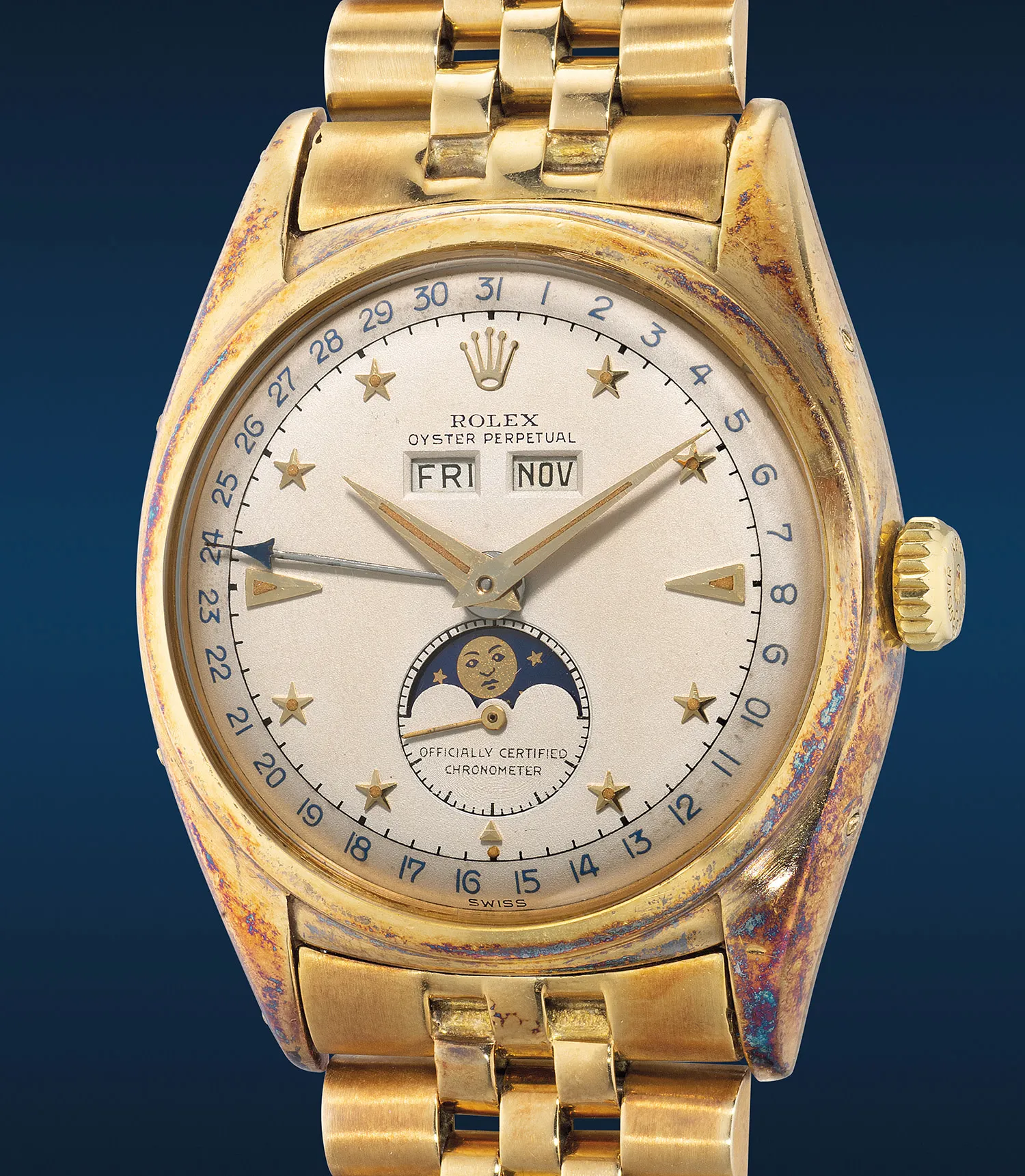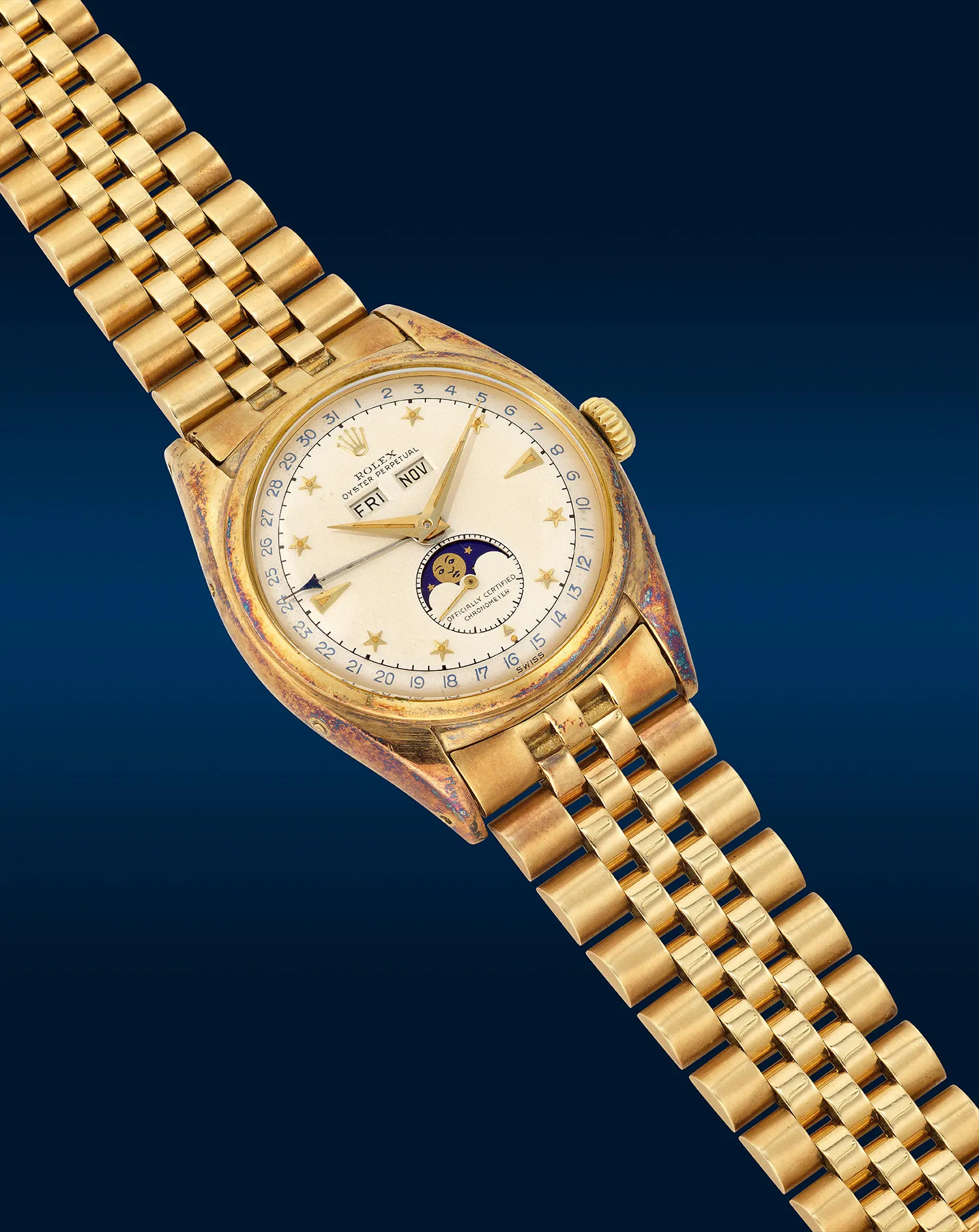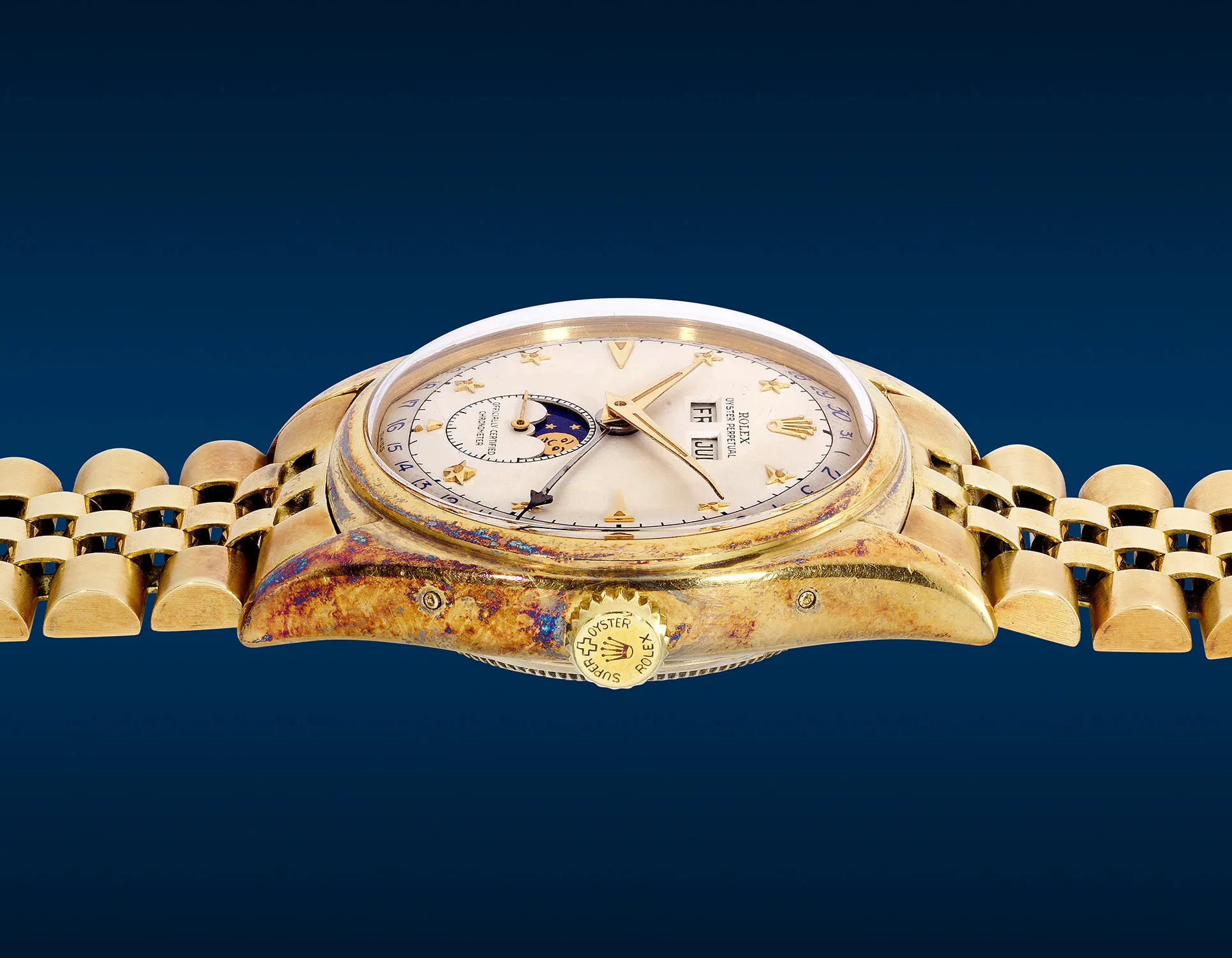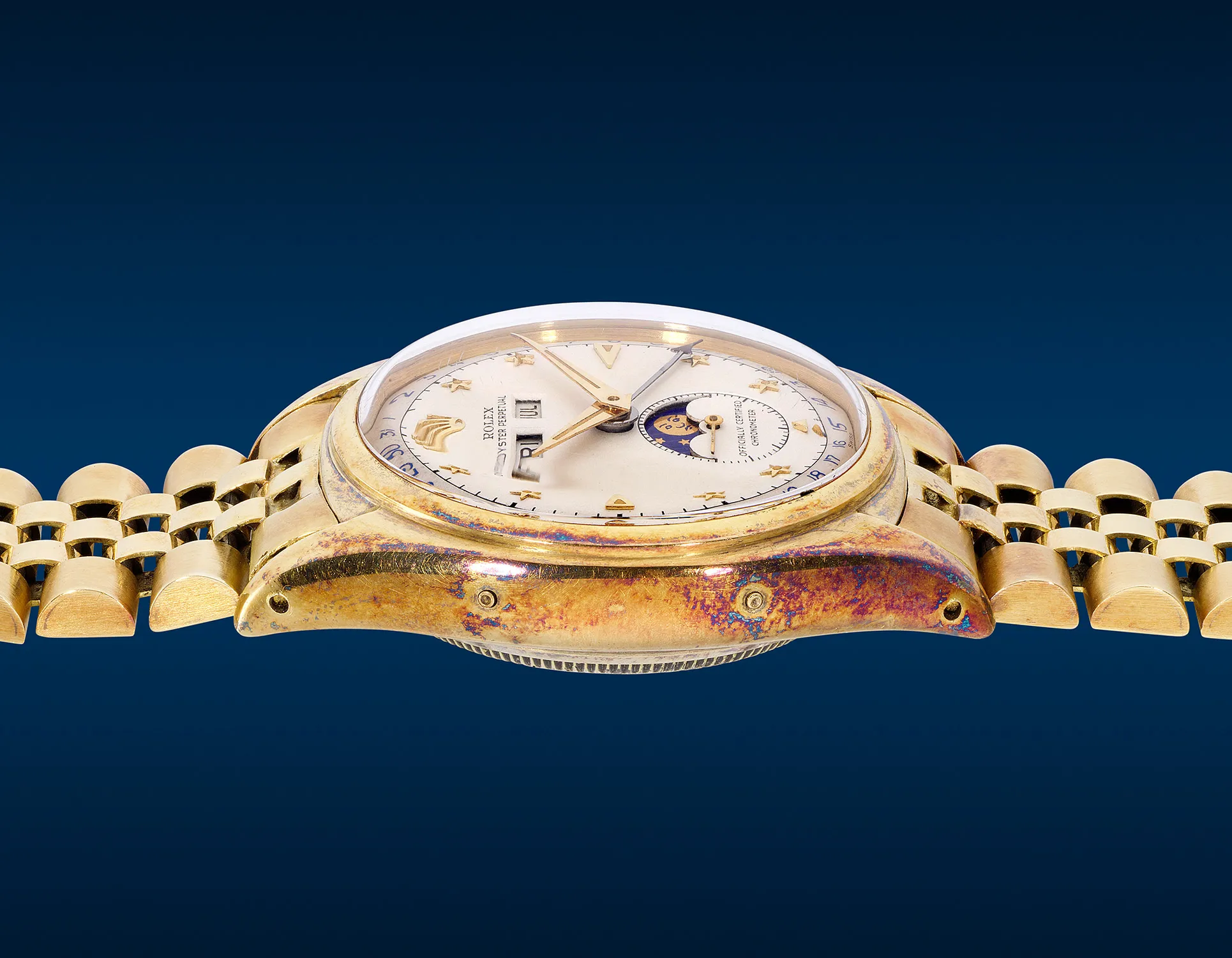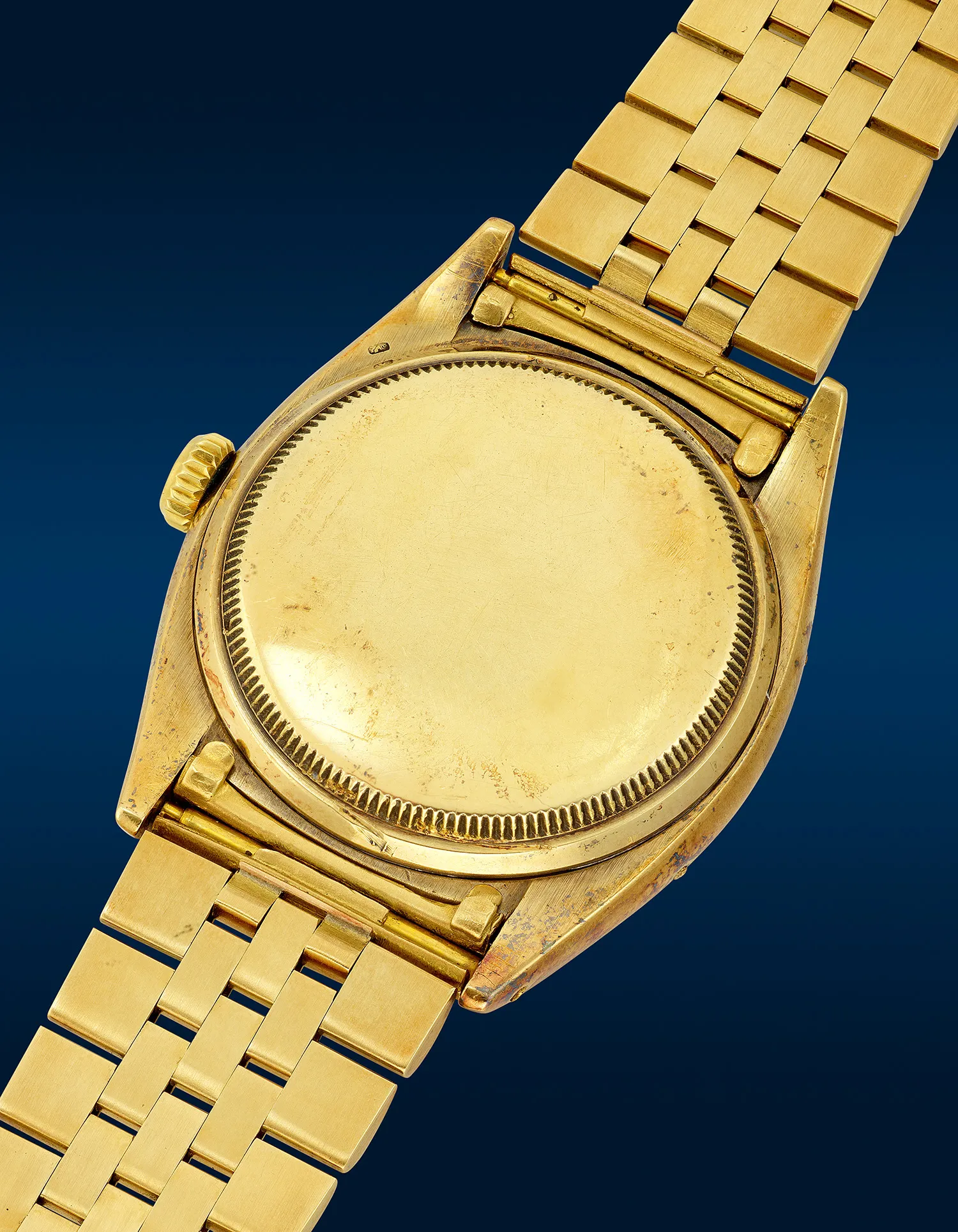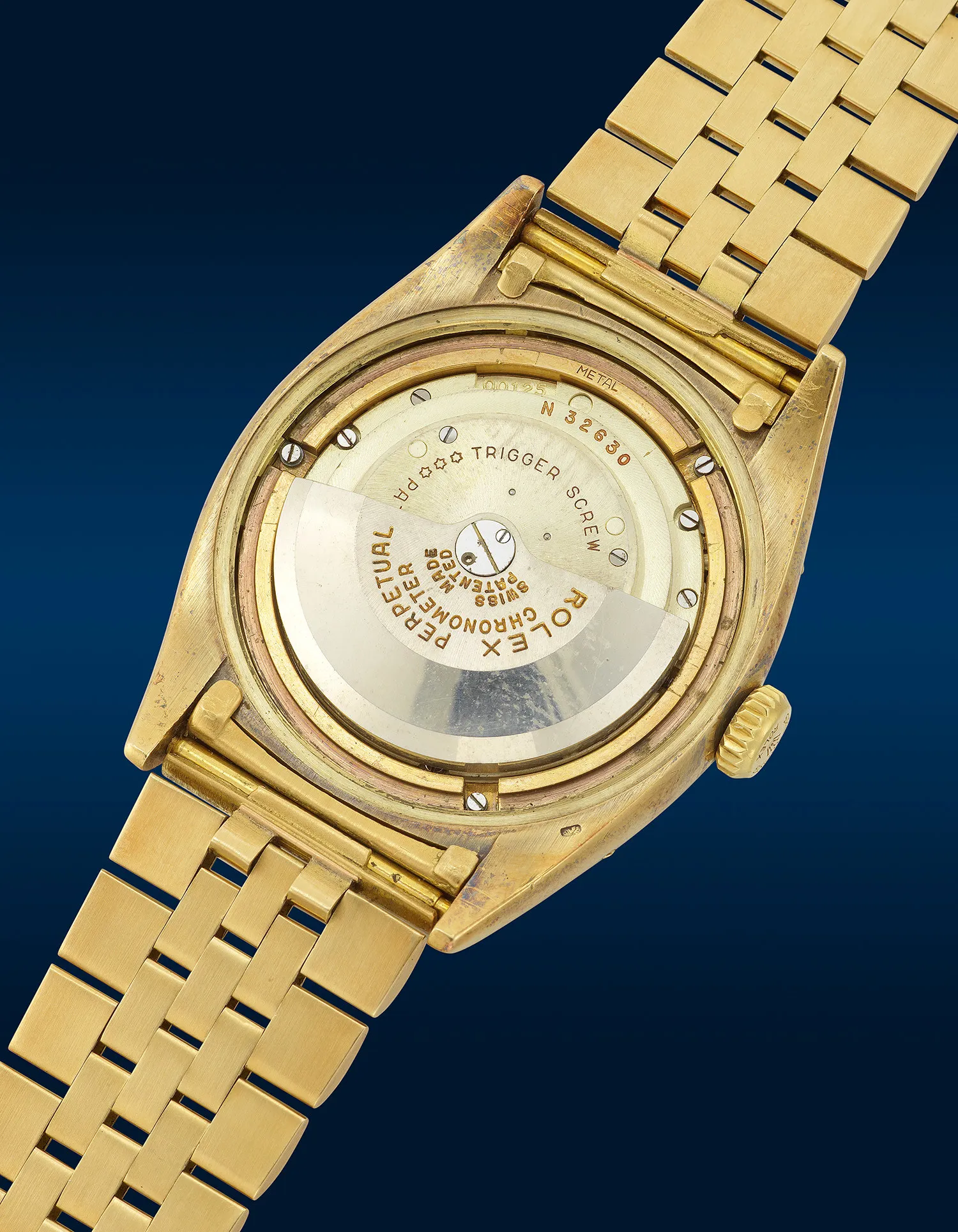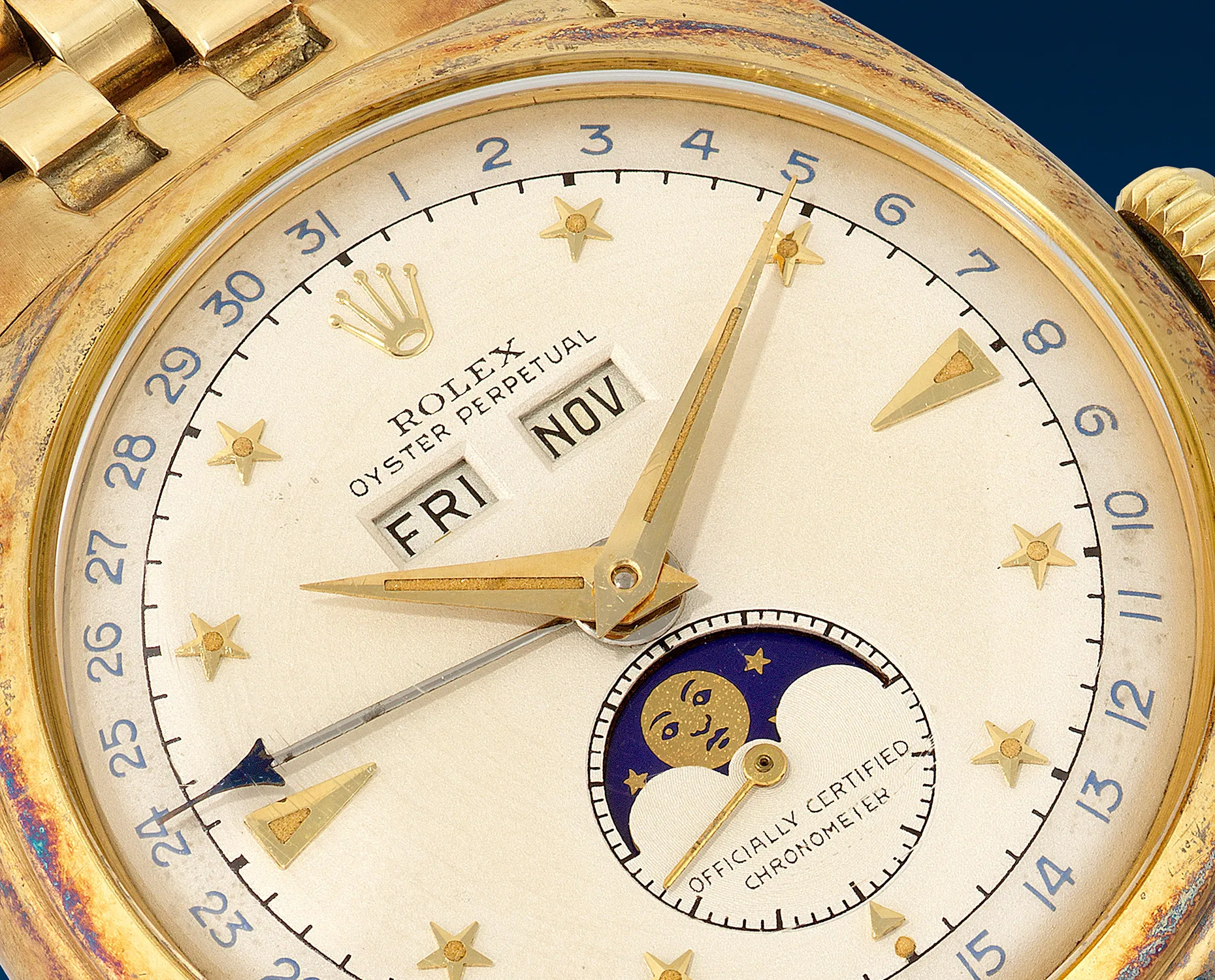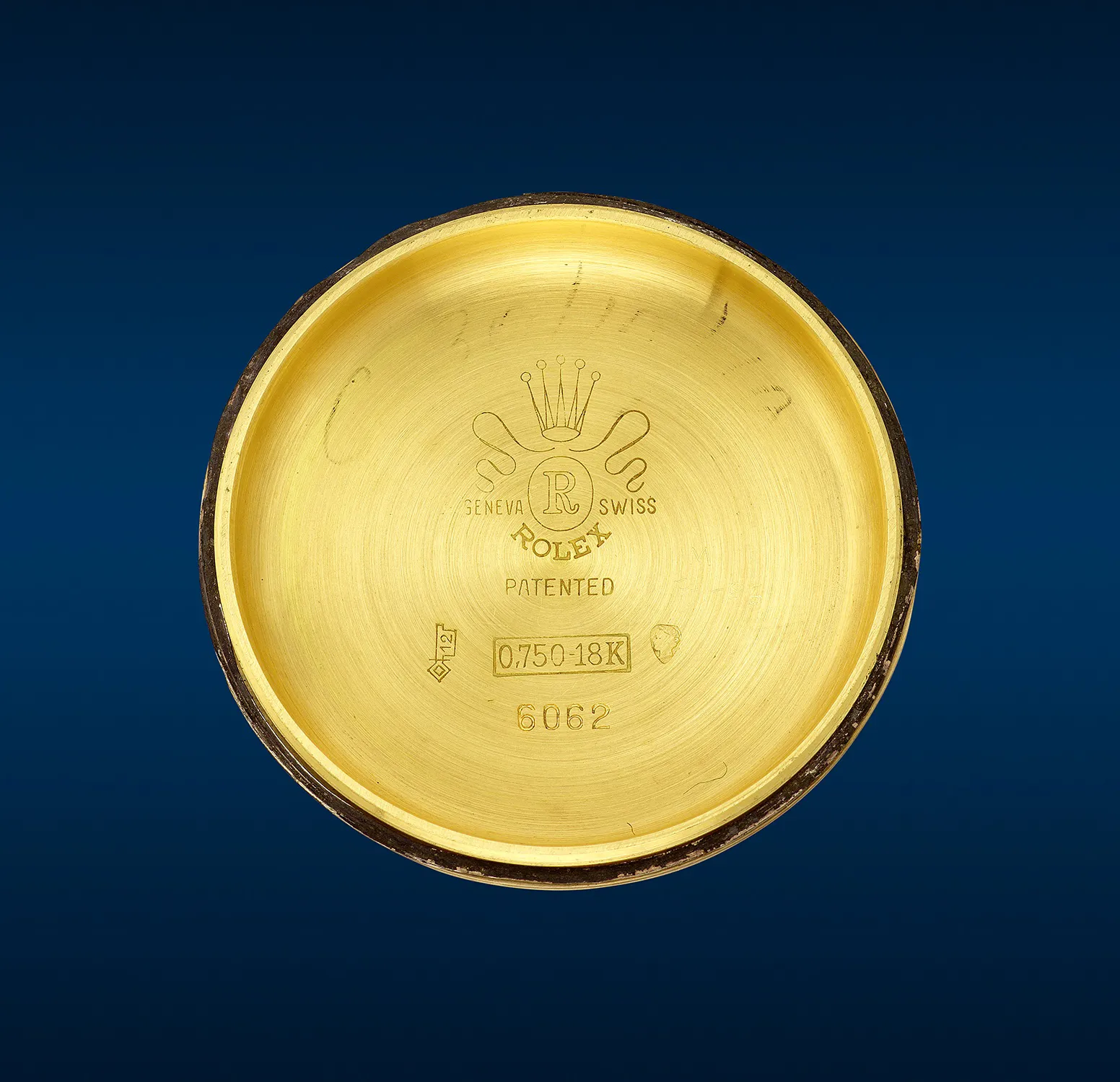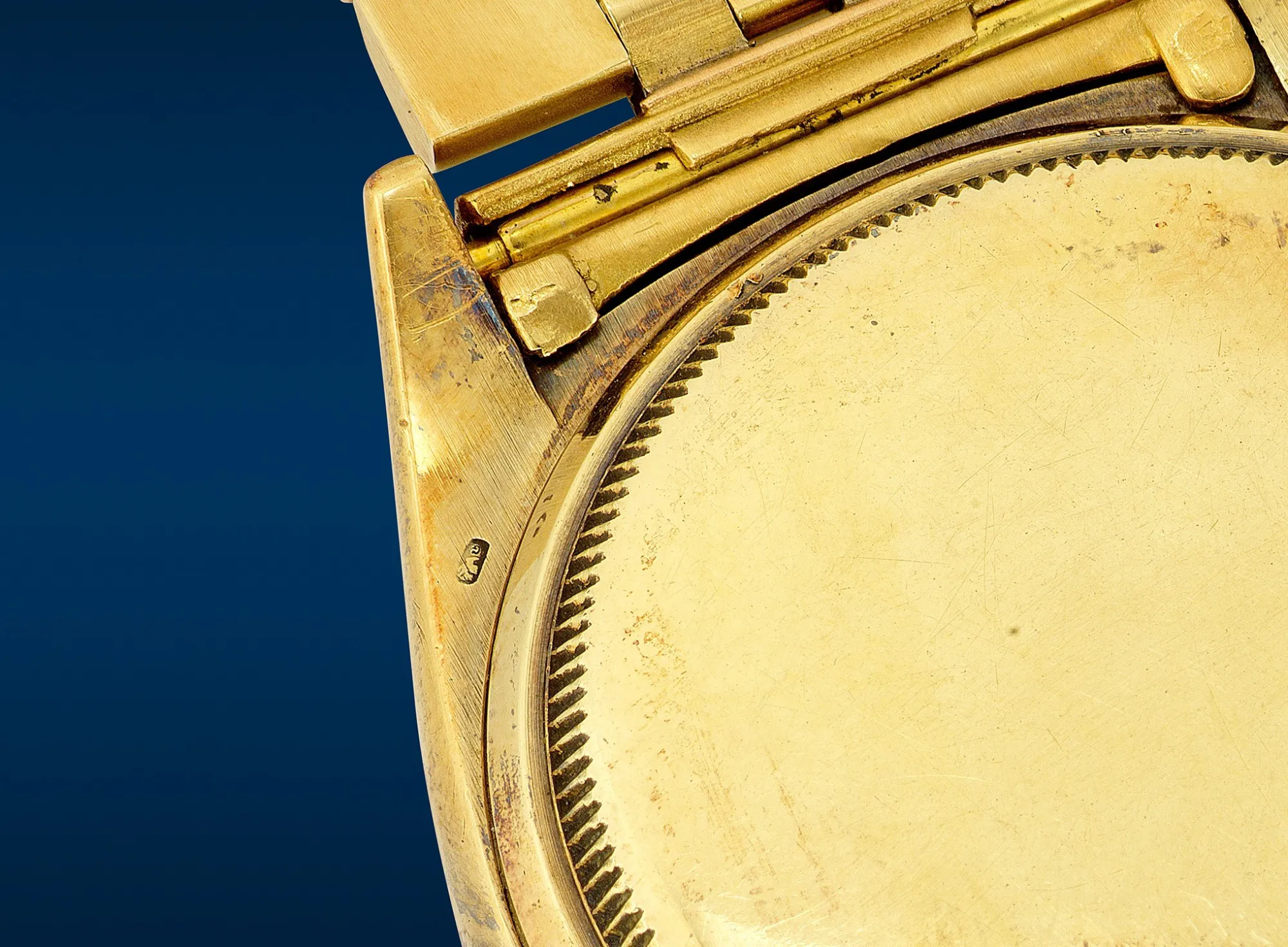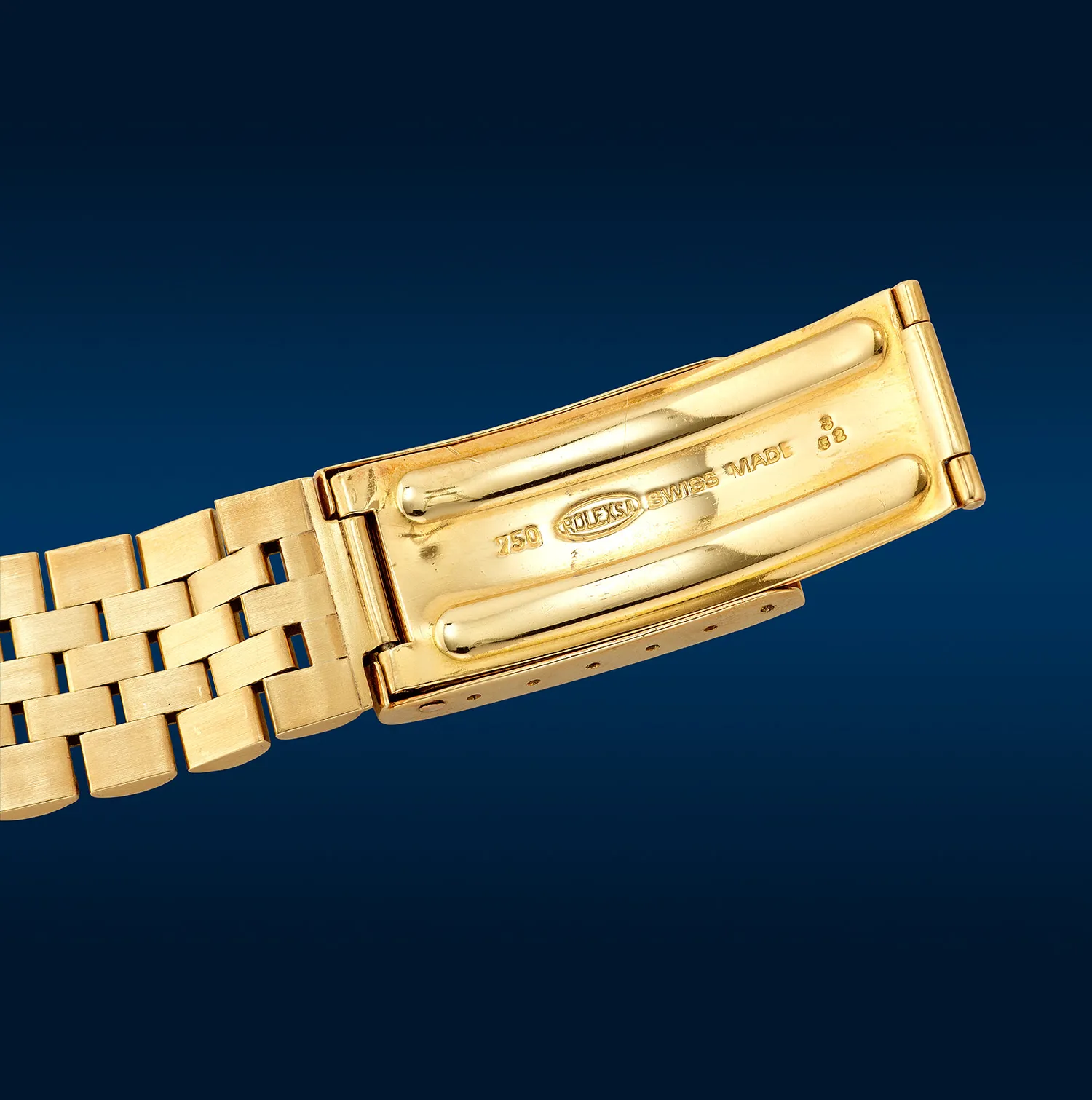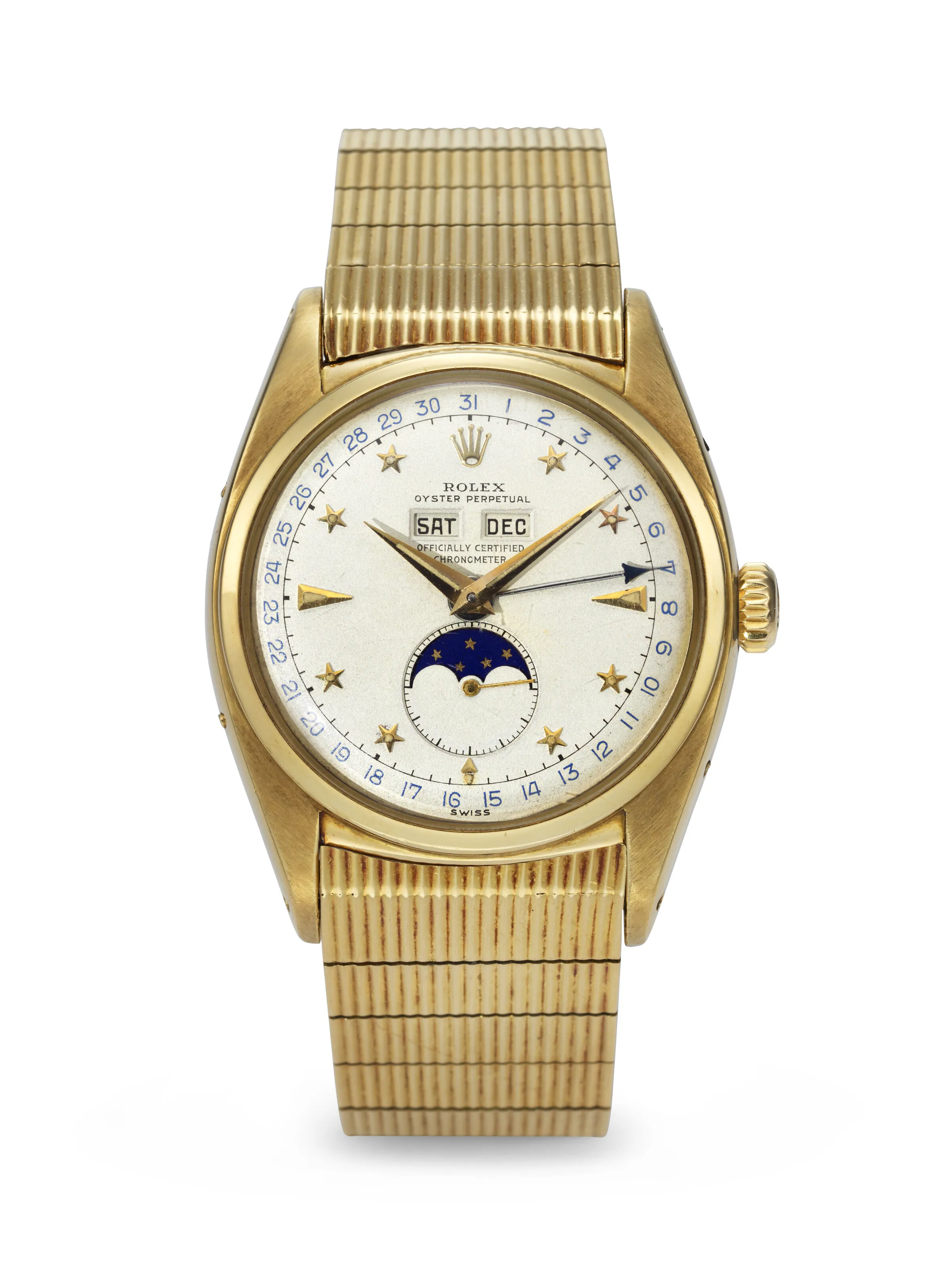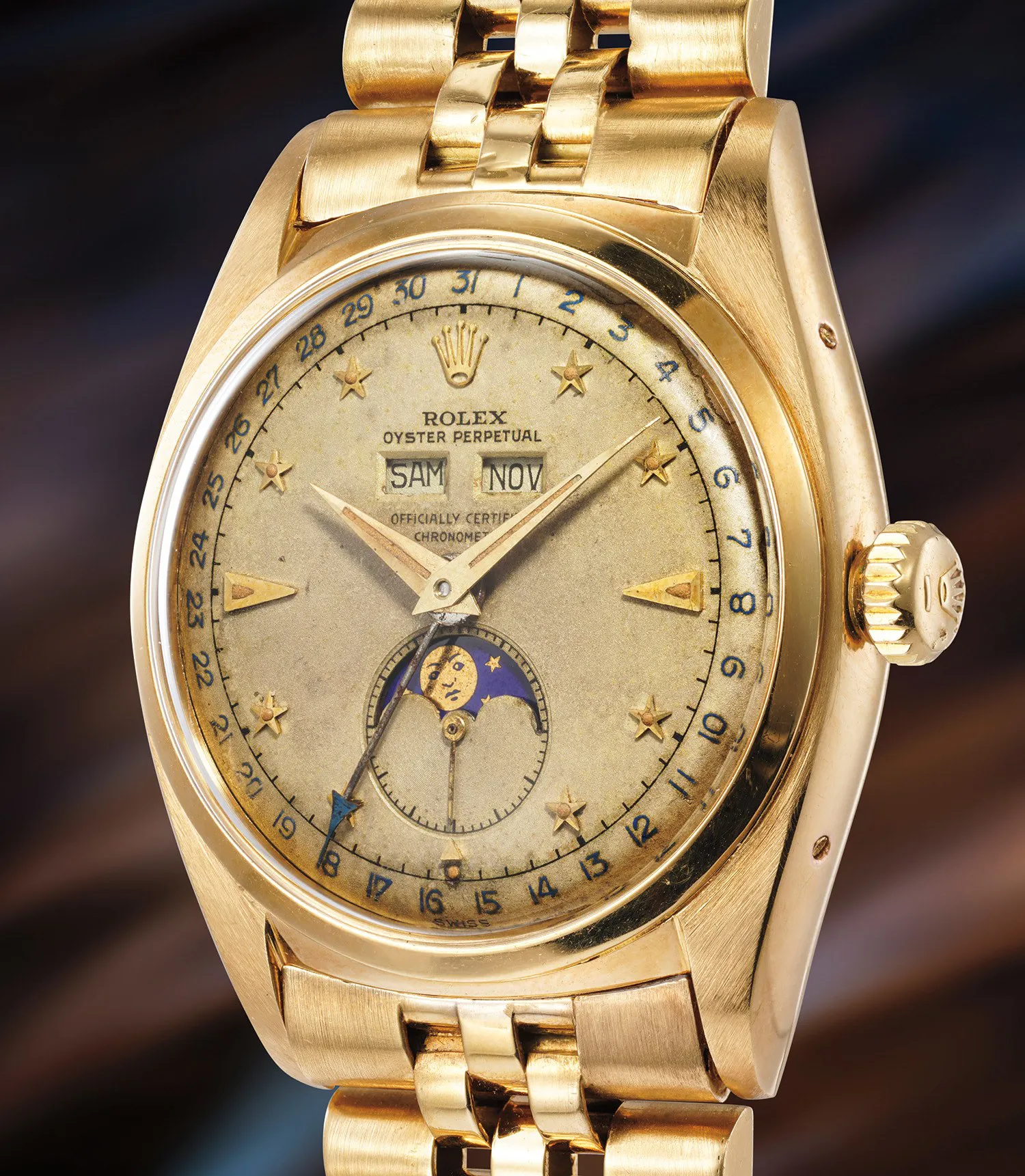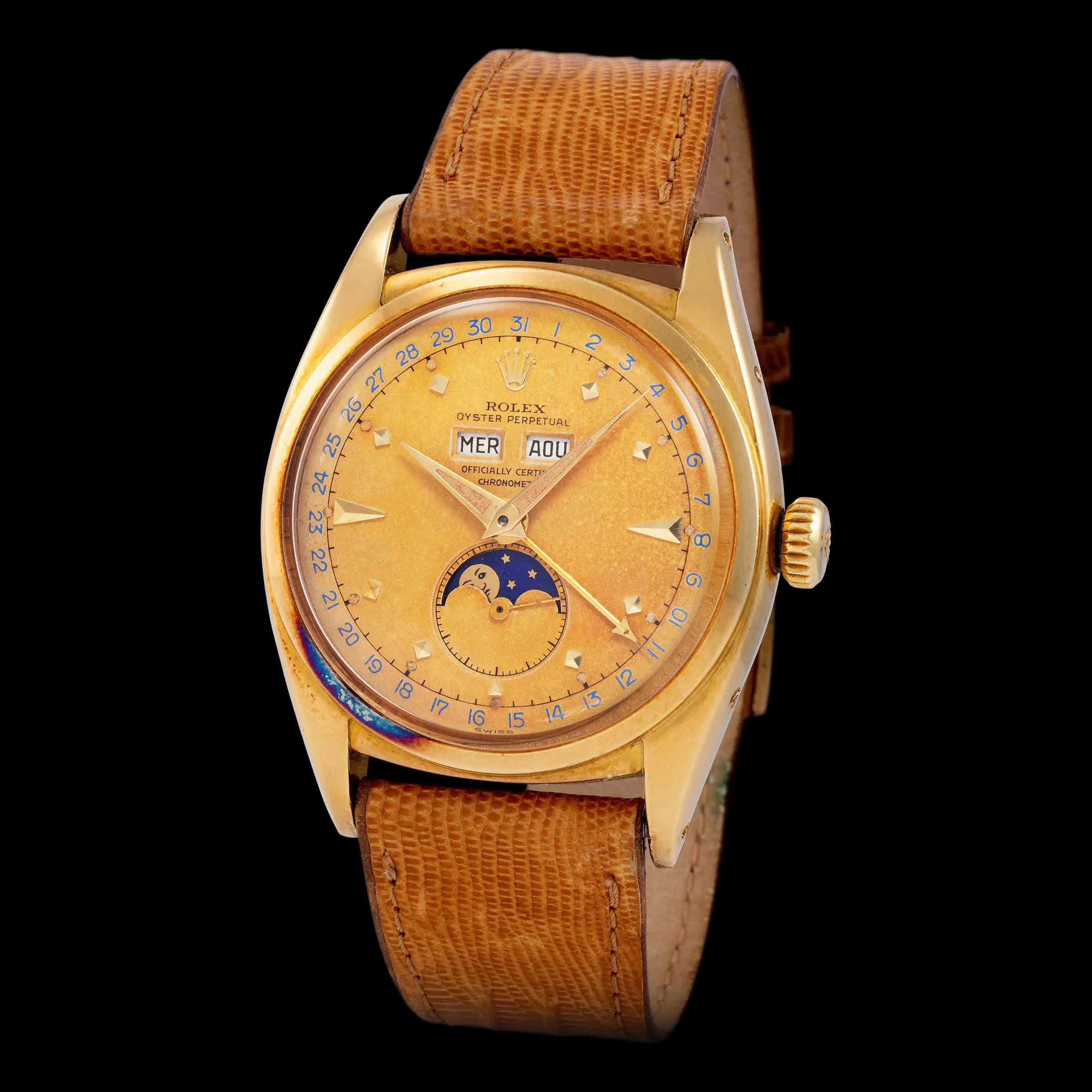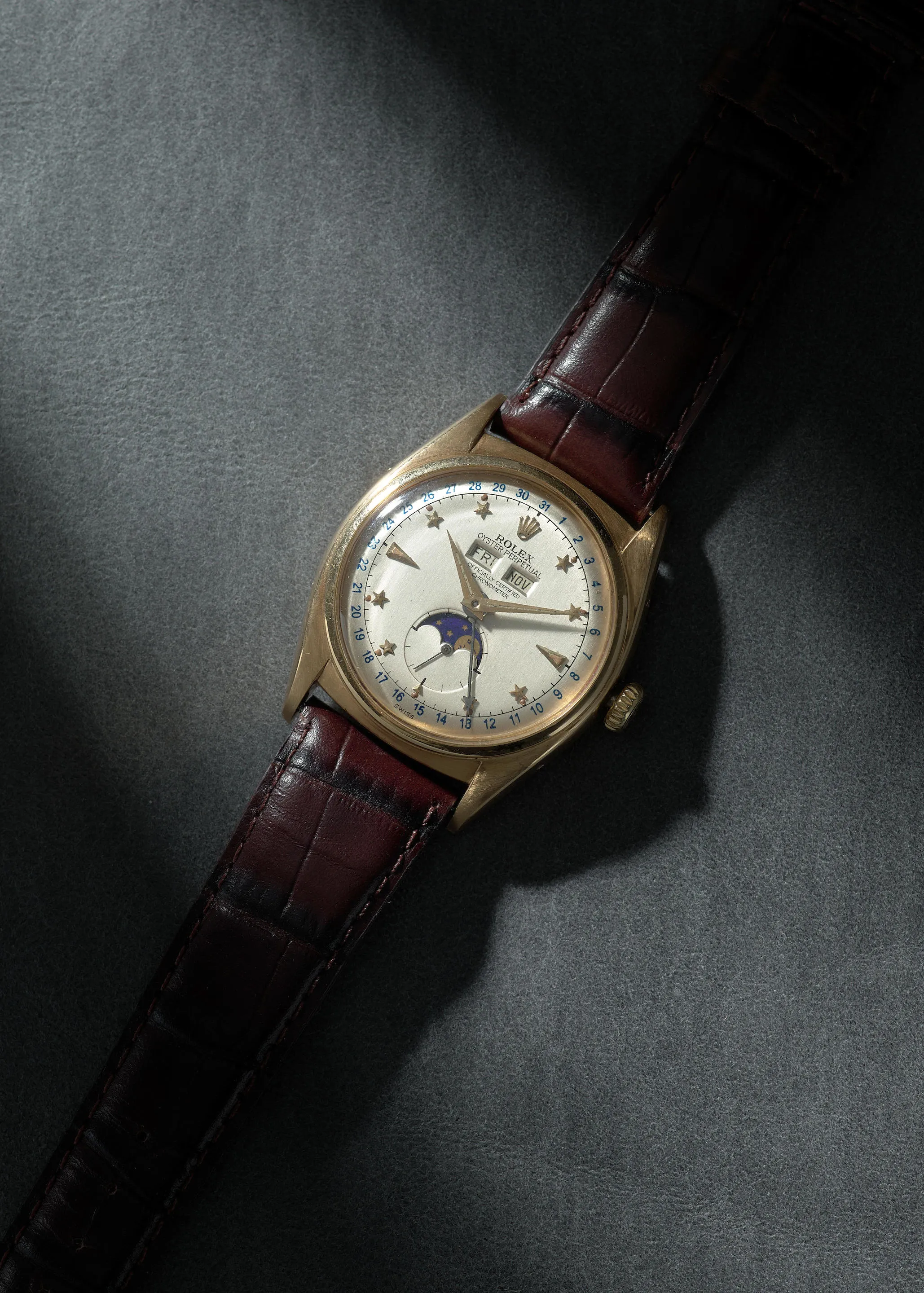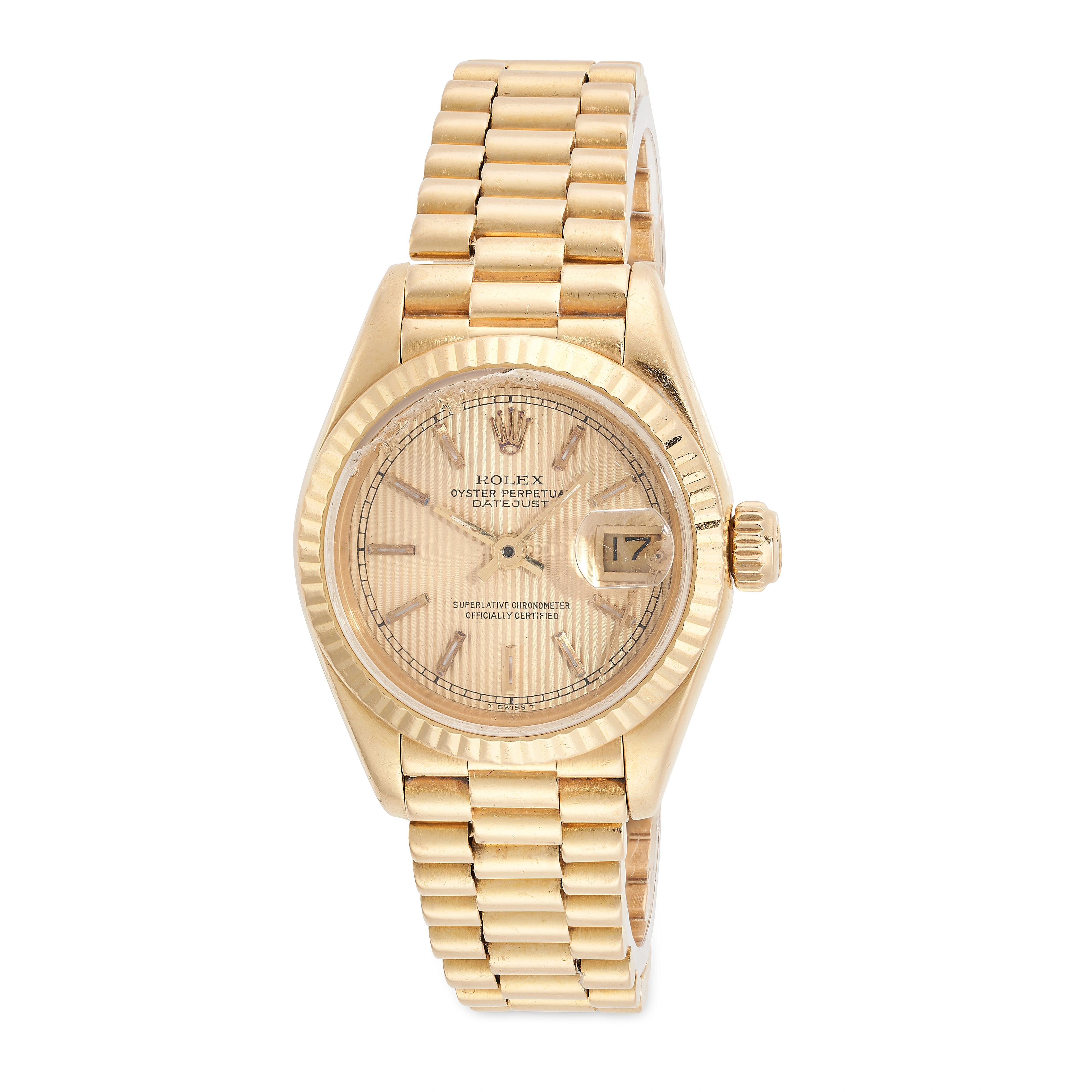Ref. 6062A highly attractive, beautifully preserved, important, and rare yellow gold triple calendar wristwatch with star-set indexes, moonphases and bracelet
View our Conditions of Sale ., Manufacturer: Rolex Year: Circa 1952 Reference No: 6062 Movement No: N32630 Case No: 911’108 Model Name: ‘Stelline’ Material: 18K yellow gold Calibre: Automatic, cal. 10 172’’’, 18 jewels Bracelet/Strap: 18K yellow gold Rolex Jubilee bracelet, max length 170 mm Clasp/Buckle: 18K yellow gold Rolex folding deployant clasp stamped "3.52" Dimensions: 36mm diameter Signed: Case, dial, movement, bracelet and clasp signed Provenance: Previously sold in Phillips Hong Kong, Rolex Milestones: 38 Legendary Watches That Shaped History, lot 816, 28th November 2016 Literature: For another example of a yellow gold reference 6062 with star dial, please see 100 Superlative Rolex Watches by John Goldberger, page 89. , Not all watches are equal. Many watches, even some of the vintage collector’s pieces, can most often be described from a distance, according to established scholarship and literature. “They are what they are”, sometimes perfect, sometimes not, but a reference number and a detailed list of the accompanying accessories, paired with a precise condition report, and the reader knows as much as the person seeing the watch up close. And then there are the other group of watches. Actually, they are no longer plain watches, they become works of art. They stand out by a number of qualities that cannot be found elsewhere – and sometimes it is the combination and large variety of qualities that make them stand out, that make them become the pinnacle of watch collecting. The present Rolex reference 6062 “Stelline” is such a watch. If there was an Olympic Pentathlon for watches, this Star (no pun intended) would be surely a prime candidate for the gold medal. What is the Pentathlon in the world of vintage collector’s wristwatches? Most scholars will probably agree it is Maker/Model, Importance, Condition, Rarity, Provenance. One thing is for sure, Rolex does not need any introduction. Like Picasso, Mouton Rothschild, or Ferrari, it is no longer simply a name for a fine product. It is the synonym for a genre, another word of the best in a certain field. Anyone comparing an artwork, Bordeaux or sports car uses these icons as reference, the gold standard in a certain field. To some extent, reference 6062 is a different scenario. It is, outside the world of hardcore collectors, a relatively little-known model. Whereas the Day-Date, Submariner and Daytona have reached a status of stardom, the “sixty-sixty-two” is a niche product and has not survived more than a handful of years in Rolex’s production – a fraction of Rolex’s mainstays that are with us and in our minds since over 50 years, sometimes even up to 70 years. Reference 6062 is a child of the early 1950s and most likely a Rolex’s own interpretation of the gentleman’s full calendar wristwatch. It is an Oyster model, fitted with a 36mm water-resistant “Ovettone”-style case. It is also equipped with Rolex’s proven and reliable self-winding calibre 9 ¾’’’ but with the added full calendar and moon phases indication. Despite the unusually small production run, reference 6062 was available in yellow and pink gold but also in stainless steel. A variety of dial version were also created but the most iconic is certainly the one fitted with star-shaped hour markers – the reason why the reference is often simply called the “Stelline” (Italian for little stars) – even the versions fitted with square, dagger or Arabic numerals. Without exaggeration, reference 6062 is one of the rarest, certainly most difficult to find models in Rolex’s post war production. The so-called “Bao Dai”, a yellow gold reference 6062 with black dial and diamond hour markers once belonging to Vietnam’s last emperor, still sits “up there” on the throne as the most valuable example of this model and as one of the most valuable vintage wristwatches of all times. Why still? Its result at Phillips Geneva dates back to 2017, broke a world-record for any Rolex ever sold at auction and was since dethroned by no other watch than the very Paul Newman of Paul Newman. What in real estate is “location, location, location” is in watches “condition, condition, condition”. All original, never restored yet perfectly well-preserved examples are the most difficult to find but also the most searched for vintage watches. Even watches with substantial price tags back in the 40s, 50s or 60s were worn. And serviced. And scratched. And polished. And again worn. And if this cycle took on average 5 years to complete, a vintage watch may have well seen 10 or even more interventions. And each time a watch is serviced, cleaned and polished, a piece of its original condition and history is lost. The present “Stelline” must have had a completely different life. Quite simply put, it shows the wear and aging one would normally associate with a 5-year-old watch. Inside the case back, where watchmakers traditional leave a code or mark when they service it, one can only identify one such mark, reading “M 7-1-85”, possibly dating to January 7th, 1985, and done by a watchmaker whose name may start with the letter M. There is another faint residue of an inscription in felt pen. This could either be a second service note or an inventory code. By decoding the inside of the case back one most conclude that that the watch has spent some 90% of its life in a drawer, box or vault. The case condition tells the same story: A sharp, very likely never polished case, with strong milling to the screwed Oyster case-back, the lovely and original satin-finish underneath the lugs, including a deep hallmark, but also wonderfully strong angles to the surfaces of the case, including the horizontal satin-finish on the side of the bezel. It appears that even the crystal is still the original one for 70 years! The movement tells us the very same story with perfectly clean surfaces and crisp screw-heads. The dial, the core of this gem’s appearance, is as good as it gets: A perfect grainé (grainy) silvered surface, quite free of scratches or so-called “burns”, shows depth and warmth – an ideal combination. The faceted month and weekday apertures are sharp, as on the day the dial left Geneva some 7 decades ago. The outer ring, calibrated from 1 through to 31, is in a wonderful medium, nearly denim-blue, printed in the typical Rolex-font with the 6s and 9s “open”. The semi-circle underneath the aperture for the moon phases retains its perfect micro-azurage on which OFFICIALLY SUPERLATIVE CHRONOMETER is printed, the highest accolade for a wristwatch movement as it confirms that is has been tested for 1 month at an observatory for its precision. The hour markers, 5-pointed stars, are of incredible finesse and proportions, where at their center a tiny dot of luminous material is applied. All of them complete and flawless, they form the perfect balance all together and harmonize and come together in an indescribable balance. The icing on the cake is the wonderfully rigid, 1952 stamped Jubilee bracelet that shows no loss of its original finish and factory firmness. And for those in the Rolex community blessed with the Indiana Jones-genes, always dreaming of the long-forgotten treasure, this Stelline displays the perfect amount of wonderful surface oxidation, mixing hues of orange, brown and purple – another proof that this treasure has not been worn or cleaned in ages but rather respectfully preserved by its owners. Speaking of its past owners and its provenance: This pièce de résistance was prominently last sold in these salerooms, at the headline grabbing Phillips Hong Kong Rolex Milestones: 38 Legendary Watches That Shaped History auction in November 2016, when it doubled its pre-sale estimate. The consignor then was, without any exaggeration, one of if not the most revered collector of vintage wristwatches, notably by Patek Philippe and Rolex, blessed with the sharpest eye and one of the longest experiences in the community. The present Stelline was then, in 2016, acquired by the current consignor, a distinguished collector of impeccable taste and with an extremely demanding eye for the highest standards for esthetics and quality, who treated it with utmost respect and practically never touched it, let alone wore it on his wrist. In terms of rarity, the equation is quite simple. Whereas Rolex produced only a very small number of references 6062 in yellow gold, examples fitted with the iconic star-shaped numerals are truly very few and particularly sought after. But when paired with a triple-A condition, we are in front of a watch that is as rare as a unicorn, quite literally. It should therefore not come as a surprise that, when preparing the thematic auction Rolex Milestones: 38 Legendary Watches That Shaped History , the teams who selected the watches composed of a committee of specialists from Phillips together with the world-renowned scholar, author and authority in the field, John Goldberger, selected this very watch to represent this model family in this landmark auction. So, going back to the first question: If there was a Pentathlon in the field of vintage wristwatches, who would be a candidate to win this prestigious competition? We believe that the answer is now known.